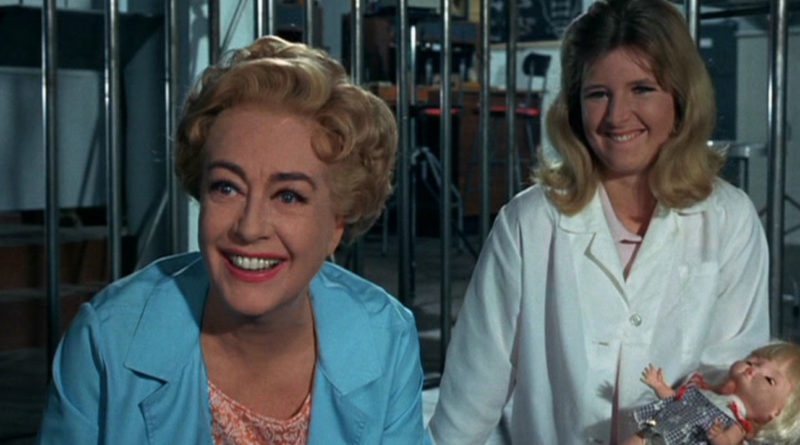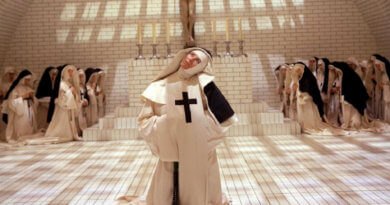The Horror Hag Genre — Part Two
Now, where were we? Oh, yes. The horror hag.
Baby Jane and Charlotte improved Bette Davis’ fortunes somewhat, and she traveled to England to make The Nanny (1965) for Hammer Films.

While it certainly falls into the “horror hag” genre, it also continues the string of rather good films she was making during the period. Bette is the titular character, a Mary Poppins from hell, and she’s terrific, affecting a believably English accent. She plays the beloved nanny of a family whose young daughter had accidentally (?) drowned in the bathtub, and the surviving sibling is convinced that she is trying to kill him, too.
And, man, is she rockin’ the eyebrows! Not since playing Charlotte Vail in Now, Voyager had she had such a couple of enormous caterpillars crawling on her forehead.
Another star hitting the horror hag circuit for Hammer at the time was Tallulah Bankhead, who was predominantly famous for her stage work but in later years was more notable for her outrageous excesses, like running around naked through hotel hallways — and her unmistakably smoky voice. In 1965’s Fanatic (aka Die, Die, My Darling!), she plays Mrs. Trefoile, a religious kook who blames her son’s ex-fiance (Stefanie Powers) for his suicide and holds her prisoner in her rural English home.
She’s surprisingly restrained here, perhaps too much. Anyone wanting to enjoy Bankhead’s trademark bizarre mannerisms (“dah-ling”) will be disappointed. And she doesn’t smoke. Nevertheless, the reports of her being so perpetually blasted on set resulted in a memorable theater piece called Looped, which I had the opportunity to see at the Pasadena Playhouse with Valerie Harper, of all people, portraying an excellent Tallulah along with Chad Allen (Dr. Quinn, Medicine Woman) as her reluctant producer.
Tallulah popped up a couple of years after the Hammer film to play the villainous “Black Widow” in the cult series Batman. Here, she delivers the mannerisms fans want to see, but it’s so evident that she’s plastered as hell, it’s both hilarious and sad.
Meanwhile, Crawford didn’t get the boost from Baby Jane that Davis did, and her motion picture career was winding down, which must have pleased Bette to no end. She also went to Europe, but the films she made there were less than stellar.
Berserk! (1968) was made by Herman Cohen, who had done some hits for American International in the ’50s (I Was a Teenage Werewolf being the most notable). He migrated to England, where he did Horrors of the Black Museum (1959), filmed in full color and featuring nasty murders in an effort to cash in on Hammer’s bloody bandwagon, after their remakes of Dracula and Curse of Frankenstein hit it big internationally.
Museum delivers the gore (including an excruciating death by spring-loaded spikes in a pair of binoculars), but it doesn’t have Hammer’s wonderful cinematography, story structure or the magnificent performances of Peter Cushing and Christopher Lee. It’s fun to watch, but for all the wrong reasons. Michael Gough (Hammer’s Dracula and the ’80s Batman remakes) is the star, minimally supported by June Cunningham, a Diana Dors lookalike (Dors was England’s answer to Marilyn Monroe) who provides the cleavage, but her range is limited. The highlight of her performance comes when she’s doing a spastic dance in a sleazy nightclub that’s so hilarious you have to rewind the tape (or DVD or DVR) to see it again. And she accidentally pokes herself in the eye as she gyrates — and they use the take!
But Berserk! is even worse. It’s saddled with a tired story about the owner and ringmaster (mistress?) of a traveling circus (Crawford) who must cope with with the violent murders of her performers right on the tanbark. Naturally, she’s doing sexy times with the much younger ’60s hunk du jour Ty Hardin. As I mentioned in the last post, Crawford was concerned about how she photographed, so at this point in her career she seems to have a distance limit that the director of photography must obey: in medium-long shots that are well-lit, it’s okay to show her neck, but come any closer and the incongruous black bars of shadow appear.
Crawford, who always thought her legs were her best feature, hits the big top in a skin-tight outfit featuring revealing fishnet panty hose and severe hairstyle, looking like some bizarre circus dominatrix.
And that’s not even the worst part. A short script forced the producers to pad the film out with lame acts and musical numbers, one of which is performed by the circus’ “freaks,” and goes on interminably while Crawford chortles with delight. To demonstrate how bereft Berserk! is, Diana Dors plays a small part, having been forced to hit the Cohen circuit after the tragic death of her progenitor (it was too soon for Monroe impersonators to be fashionable). And yes, Michael Gough makes a brief appearance in the first of his two films with Crawford.
Meanwhile, Davis made The Anniversary for Hammer, starring as the abusive one-eyed matriarch of a dysfunctional family. She’s fun as she verbally hacks her children and grandchildren to pieces, but like all forced camp, it doesn’t really work.
The same year in the U.S., Roman Polanski’s magnificent Rosemary’s Baby hit the screens. Not only is it a freaking great horror film, it’s also a terrific time capsule of New York in the 1960s, a location and era that I would’ve loved to have been an adult in. Ruth Gordon plays the neighbor from hell, whose nosiness and constant prying deflects what’s really going on — the intention to impregnate Rosemary with Satan’s baby.
Gordon won the supporting actress Academy Award for her performance, and it’s well-deserved. Minnie adds just the right mundane tone and day-to-day blah-blah-blah to make Rosemary not notice that a group of elderly satanists are making plans to have her raped by the devil.
Don’t believe how great she was? Catch it on cable and watch the scene where Minnie is serving Rosemary’s (Mia Farrow) husband, Guy (John Cassavetes), some of her homemade cake. Messily cramming forkfuls into her mouth, she watches intently to make sure he’s enjoying it, mugging relentlessly through the other actors’ dialogue (“Guyyyy?”), and swooping in to offer him another slice. Sure, she’s shamelessly stealing the scene, but she’s hilarious.
Remember, true horror hag films must have questions as the titles, so Gordon made the grade in the Robert Aldrich-produced Whatever Happened to Aunt Alice? (1969). Geraldine Page stars as a pine-tree growing widow who murders a succession of housekeepers for their money and buries them in the garden. Gordon arrives to investigate the disappearance of her friend, who had been dispatched by Page, and the mayhem ensues.
Sadly, Crawford’s last theatrical release, also for Cohen, was Trog (1970). She plays Dr. Brockton, an anthropologist who discovers a troglodyte in a cave and wants to study, much to the dismay of the locals, led by religious fanatic Sam Murdock (Gough again), who wants it dead. The film is dull and the troglodyte makeup is ridiculous—a hair shirt topped off with an ape head. Still, Crawford, brings a surprising dedication to her role. She finished her career playing bit parts on television, the most notable of which was the pilot for Night Gallery (1969), in which she was directed by a young Steven Spielberg.
In 1971, eclectic director Curtis Harrington made two horror hag films, both starring Shelley Winters, What’s the Matter with Helen? and Whoever Slew Auntie Roo? Of the two, Helen is more interesting. It’s set in the 1930s, and Winters and Debbie Reynolds star as Adele and Helen, two midwestern mothers whose sons have been sentenced to prison for a Leopold and Loeb-style murder. To escape their shame, they relocate to Hollywood where they open a dance studio for aspiring Shirley Temples. The weight of her guilt and suppressed romantic feelings for Helen proves too much for Adele, though, and she loses it.
Shot for not a lot of money, it has a marvelous period flavor, the creepy little Shirley Temple impersonators are fun, and the great Agnes Moorehead roars onscreen as the fire-and-brimstone breathing Sister Alma, modeled after real-life evangelist Aimee Semple McPherson.
In Whoever Slew, Winters plays Auntie Roo, a seemingly kindhearted and wealthy matron who lives in an English country mansion and has an annual custom of bringing children from the local orphanage into her home for the Christmas holidays. One of the kids (played by Oliver himself, Mark Lester) is convinced that she’s a witch, intent on fattening him up and eating him. Winters’ performance is suitably broad and it has a nice fairytale feel, but it’s kind of ho-hum after the many pleasures of Helen.
Part Three—Horror Hags on TV—coming up next!









